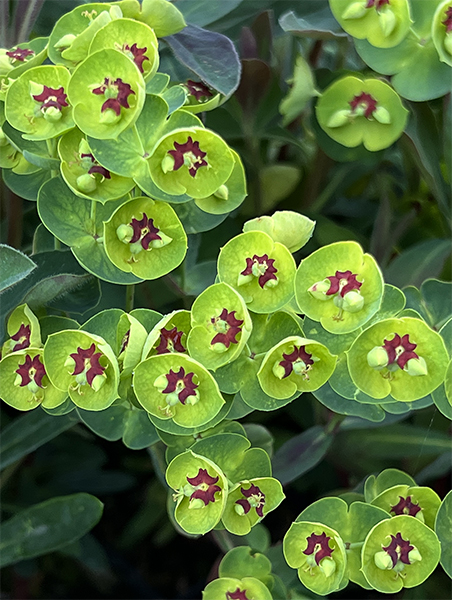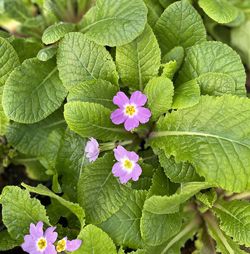
Euphorbia
Milkwort
Named after Euphorbus, physician to the king of Mauritania, this robust, sun-loving genus includes the familiar Poinsettia and is over 1600 species strong. Most Euphorbia have a poisonous milky sap and soft-colored bracts that surround subtly defined flowers. Autumn watches many of their narrow green leaves turn shades of red, orange and yellow.
Each 11.75

A well-loved garden mainstay since the late 1800s, this naturally occurring evergreen hybrid between Euphorbia amygdaloides and Euphorbia characias was discovered in France. Stiff upright stems plus narrow lance-shaped ash-green leaves define the dapper compact mound that bolsters voluminous dense terminal cymes with burgundy-centered lime-yellow bracts. Equally at ease in traditional borders or more modern venues, Euphorbia x martini′s hardy subshrub-like habit toughs coastal sites, dry conditions, lean soil and deer, while its zingy long-lasting flowers, purple-tinged new growth and red-stained winter-time stalks afford vivacious multiseason allure.
Blooms March–June
Size: 2' 0" high x 2' 0" wide.
Hardy to zone 6.
Please fill out our Registration Form to receive news of updates to the web site, availability of new plants, give us your feedback, and to be on the mailing list to receive future printed catalogs.
Other selections in this genus:
- Euphorbia ‘Acid Wash’
- Euphorbia amygaloides ‘Ruby Glow’
- Euphorbia ‘Blackbird’
- Euphorbia ‘Blue Haze’
- Euphorbia ‘Canyon Gold’
- Euphorbia characias ssp. wulfenii
- Euphorbia characias ‘Bruce’s Dwarf’
- Euphorbia characias ssp. wulfenii ssp. wulfenii ‘John Tomlinson’
- Euphorbia characias ssp. wulfenii ‘Lambrook Gold’
- Euphorbia characias ‘Red Wing’
- Euphorbia ‘Copton Ash’
- Euphorbia ‘Dean’s Hybrid’
- Euphorbia donii (Dixter Form)
- Euphorbia ‘Excalibur’
- Euphorbia griffithii ‘Fern Cottage’
- Euphorbia griffithii ‘Fireglow’
- Euphorbia griffithii ‘Great Dixter’
- Euphorbia ‘Helen Robinson’
- Euphorbia ‘Jade Dragon’
- Euphorbia ‘Limewall’
- Euphorbia longifolia
- Euphorbia mellifera
- Euphorbia myrsinites
- Euphorbia polychroma ‘Candy’
- Euphorbia rigida
- Euphorbia sikkimensis











